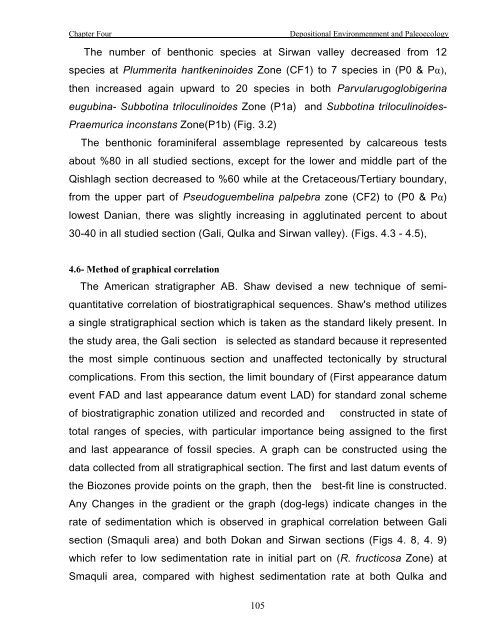biostratigraphy and paleoecology of cretaceous/tertiary boundary in ...
biostratigraphy and paleoecology of cretaceous/tertiary boundary in ...
biostratigraphy and paleoecology of cretaceous/tertiary boundary in ...
Create successful ePaper yourself
Turn your PDF publications into a flip-book with our unique Google optimized e-Paper software.
Chapter Four<br />
Depositional Environmenment <strong>and</strong> Paleoecology<br />
The number <strong>of</strong> benthonic species at Sirwan valley decreased from 12<br />
species at Plummerita hantken<strong>in</strong>oides Zone (CF1) to 7 species <strong>in</strong> (P0 & Pá),<br />
then <strong>in</strong>creased aga<strong>in</strong> upward to 20 species <strong>in</strong> both Parvularugoglobiger<strong>in</strong>a<br />
eugub<strong>in</strong>a- Subbot<strong>in</strong>a trilocul<strong>in</strong>oides Zone (P1a) <strong>and</strong> Subbot<strong>in</strong>a trilocul<strong>in</strong>oides-<br />
Praemurica <strong>in</strong>constans Zone(P1b) (Fig. 3.2)<br />
The benthonic foram<strong>in</strong>iferal assemblage represented by calcareous tests<br />
about %80 <strong>in</strong> all studied sections, except for the lower <strong>and</strong> middle part <strong>of</strong> the<br />
Qishlagh section decreased to %60 while at the Cretaceous/Tertiary <strong>boundary</strong>,<br />
from the upper part <strong>of</strong> Pseudoguembel<strong>in</strong>a palpebra zone (CF2) to (P0 & Pá)<br />
lowest Danian, there was slightly <strong>in</strong>creas<strong>in</strong>g <strong>in</strong> agglut<strong>in</strong>ated percent to about<br />
30-40 <strong>in</strong> all studied section (Gali, Qulka <strong>and</strong> Sirwan valley). (Figs. 4.3 - 4.5),<br />
4.6- Method <strong>of</strong> graphical correlation<br />
The American stratigrapher AB. Shaw devised a new technique <strong>of</strong> semiquantitative<br />
correlation <strong>of</strong> biostratigraphical sequences. Shaw's method utilizes<br />
a s<strong>in</strong>gle stratigraphical section which is taken as the st<strong>and</strong>ard likely present. In<br />
the study area, the Gali section is selected as st<strong>and</strong>ard because it represented<br />
the most simple cont<strong>in</strong>uous section <strong>and</strong> unaffected tectonically by structural<br />
complications. From this section, the limit <strong>boundary</strong> <strong>of</strong> (First appearance datum<br />
event FAD <strong>and</strong> last appearance datum event LAD) for st<strong>and</strong>ard zonal scheme<br />
<strong>of</strong> biostratigraphic zonation utilized <strong>and</strong> recorded <strong>and</strong> constructed <strong>in</strong> state <strong>of</strong><br />
total ranges <strong>of</strong> species, with particular importance be<strong>in</strong>g assigned to the first<br />
<strong>and</strong> last appearance <strong>of</strong> fossil species. A graph can be constructed us<strong>in</strong>g the<br />
data collected from all stratigraphical section. The first <strong>and</strong> last datum events <strong>of</strong><br />
the Biozones provide po<strong>in</strong>ts on the graph, then the best-fit l<strong>in</strong>e is constructed.<br />
Any Changes <strong>in</strong> the gradient or the graph (dog-legs) <strong>in</strong>dicate changes <strong>in</strong> the<br />
rate <strong>of</strong> sedimentation which is observed <strong>in</strong> graphical correlation between Gali<br />
section (Smaquli area) <strong>and</strong> both Dokan <strong>and</strong> Sirwan sections (Figs 4. 8, 4. 9)<br />
which refer to low sedimentation rate <strong>in</strong> <strong>in</strong>itial part on (R. fructicosa Zone) at<br />
Smaquli area, compared with highest sedimentation rate at both Qulka <strong>and</strong><br />
105

















